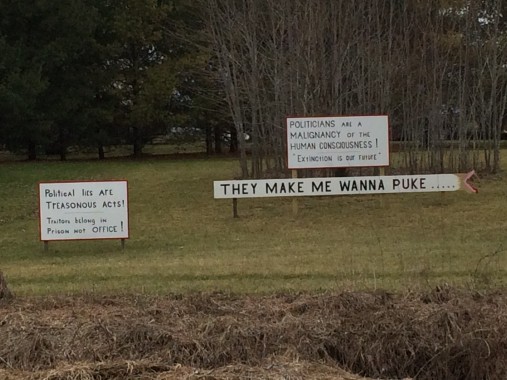For the month of February, each writer’s post will begin with the same line, which we’ve borrowed from Kurt Vonnegut’s Slaughterhouse-Five.
All this happened, more or less.
I was driving solo across the backroads of Lenawee County last weekend, in what has become a routine expedition: my mission to visit every city, town, and village in the state of Michigan. I’d spent the night with a friend in Ann Arbor before meandering to the Lake Erie coast and back, nabbing towns and sampling local culture wherever possible.
You never know what you might come across when traversing rural America, and here in the hinterlands of the Wolverine State I’ve encountered everything from outhouse races to a magician cemetery, but one thing you can count on—whether you like it or not—is the proud display of political opinion. November was some time ago now; campaign signs have mostly been stashed away in chagrined defeat or smug victory.
But some are still determined to make their voices heard, some more loudly than others. In terms of delivery, it seems nothing beats the good old, tried-and-true yard sign.
On this particular afternoon, I came across the motherload of all yard signs. At the intersection of two dirt roads stood three wooden signs, each over six feet long and just as tall, screaming, “Political lies are TREASONOUS acts! Traitors belong in PRISON, not OFFICE!” “POLITICIANS are a MALIGNANCY of the HUMAN CONSCIOUSNESS! Extinction is our future!” “THEY MAKE ME WANNA PUKE…..”
If the intent was to get motorists to stop and contemplate, the author succeeded, because I’ve been thinking about those signs for days now. Think about all that goes into a display like that. All the time it takes to acquire the materials, decide on the message, erect the signs, and paint them. They were constructed with great care, painted with precision, and installed with importance. The vocabulary was clearly chosen after intense deliberation. And as the venerable Kelly Kapoor notes, there is profound intent lurking behind the rare and malevolent five-dot ellipsis. These were “final draft” thoughts I was reading.
‘When were these signs put up?’ was my first question. Was it during the Obama administration? During this rollercoaster-hurricane of an election cycle? If they were aimed at Hillary—as many of my rural weekend jaunts proved to be a trend—leaving them up in mid-February sort of gives passers-by the wrong impression (In an amusing twist of coincidence, by the way, this property happens to be located just outside the village of Clinton, Michigan). Were they aimed at Trump? Rick Snyder? Flint Water Crisis? Perhaps these are the thoughts of a disgruntled farmer who’s simply witnessed too much on both ends of the spectrum, enough to declare the whole system a rigged atrocity.
But then again, “disgruntled” doesn’t really describe this justly. These are the carefully crafted thoughts of the genuinely outraged, the boiling point of the infuriated, the roar of the supremely pissed-off!
Anger has never been something I’ve empathized with. I dislike confrontation. I prefer to just keep my nose down and let personal slights glide under the radar. But more than that, I simply don’t get riled; I was never wired that way, a mentality that harks back to “The Philosophy of Oh Well.” I see a Confederate flag and I roll my eyes; I see the White House lit up in rainbow and I shrug with indifference. But in spite of my empathetic dead zone, these signs came as a bit of a revelation to me:
Maybe I should care more.
When Donald Trump was elected President, I was disappointed. That was about it. I went to work and didn’t bring it up, though there was clearly a pall throughout the greenhouse and a sense of grief among my coworkers, the majority of whom are Hispanic. When Trump took office and began appointing unqualified executives, enacting travel bans, and silencing climate scientists, I grew frustrated. I’d exchange a few grim comments with my peers, and then that was about it.
More recently, Taryn and I were talking about everything going on, and she asked me what we should do about it. “What do you mean, what should we do?” I responded, a bit awkwardly. A negative voice inside almost spat, “Why do we need to do something?” but I held my tongue. That’s no way to think. But the question hung there regardless.
I’ve never felt compelled to join a protest or participate in a march, and I think Facebook tirades are a waste of time. People will continue to ingest the information they want to hear and seek confirmation for beliefs they already hold. I’m sure I’m the kind of Democrat that Republicans can tolerate with ease. “If he has to be a liberal, at least he’s a complacent liberal,” they might think, and it’s easy to get along with the other side when they don’t fight very hard.
Staying complacent is getting harder, though. As an outdoor rec enthusiast, Trump’s environmental policies irritate me for selfish reasons. Under an administration that silences scientists, disbands the Environmental Protection Agency, and sells National Park land to developers and oil companies, the next four years could undo decades of hard-fought practice in sustainability.
On Thursday, February 16, production came to a grinding halt at the greenhouse because most of my coworkers took a personal day for the nationwide protest, “A Day Without Immigrants.” No trucks came for pick-ups or deliveries. There was nothing to pick-up, and no one to receive deliveries. There were no production crew to load racks or plant seeds, and therefore nothing new for my fellow section growers to water in. Across America, there was essentially zero productivity for companies that rely heavily on the work ethic of immigrant labor. I’ve been employed in the agricultural industry my entire life, plenty of time to witness their colossal influence to the American workforce.
When cheap labor is the bottom line, it’s easy to see why companies hire the way they do. Deporting millions from our workforce might present to the ag industry a similar dilemma to the Fair Standards Labor Act, which required all businesses to pay their employers time-and-a-half for hours worked past forty. Recognizing that the industry would collapse by changing the way businesses survived, lawmakers created the “agricultural exception,” and as a result I’ve been working forty-five to seventy hours a week at standard pay. Businesses like farms and greenhouses that are so heavily reliant on immigrant labor might not be able to weather another hit like that without negotiating further work-visa exceptions to Trump’s deportation policies, and ag only scratches the surface of trades that employ a majority of immigrant labor.
All this goes to suggest that it’s probably time to do something. If you’re disgruntled about the way things are going—hell, if you’re utterly and completely enraged—take action! When I look on Instagram and see my soft-spoken, sixty-four-year-old librarian aunt hoisting a “Dissent Is Patriotic” sign at a Women’s Rally in Sioux Falls, South Dakota, there certainly isn’t an excuse for me not to care. Maybe it’s time to volunteer more. Help a refugee learn English or apply for jobs. Assist a Latino coworker applying for citizenship. Research global warming, economics, the Constitution, and the Middle East. In the information age, it doesn’t take a strained effort to be part of the conversation. It’s being an informed conversationalist that’s the real trick.
It’s time to care more.

Nick Meekhof (’15) graduated with a major in writing and a minor in geography. A farmer for the first twenty-three years of his life, Nick currently works for the Michigan Department of Agriculture. When he’s not traversing the state conducting orchard inspections, he can be found exploring the rivers, forests, and small towns all throughout the Great Lakes State. His current goals include kayaking one hundred Michigan rivers, swimming in Lake Michigan during every month of the year, and visiting as many Michigan breweries as possible.








